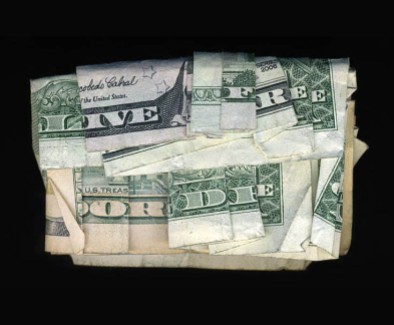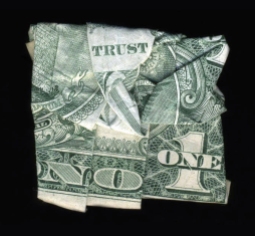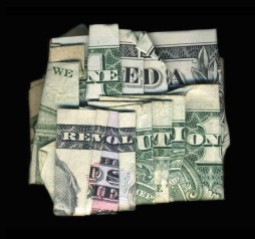O trabalho de Dan Tague desperta uma reflexão sobre o poder do dinheiro no mundo capitalista. Ele, literalmente, faz o dinheiro falar, dobrando cuidadosamente as cédulas, para que formem frases inusitadas com as letras impressas nas notas. Depois fotografa e amplia em grandes formatos, revelando pequenos detalhes que no tamanho real passam despercebidos.
A série “Money Talks” surgiu como forma de protesto, em 2005, quando Tague se viu abandonado pelo governo, após o Furacão Katrina destruir sua casa em New Orleans, levando tudo que tinha. Salvaram-se algumas notas de dólar e uma câmara fotográfica. Foi o suficiente para ele criar sua mais famosa série. As cédulas de dólar eram amassadas, como se maltratadas pela indignação do artista, formando frases revolucionárias, que assumem um significado surpreendente quando “ditas” pelo o maior ícone do capitalismo.
Tague deixou para trás um estúdio aniquilado, e conseguiu uma residência no KALA Art Institute, em Berkeley, Califórnia. Suas primeiras peças se tornaram fortes símbolos políticos, como as obras-primas “We Need a Revolution”, “Trust No One”, “State of Fear”, “Live Free or Die” e “Holy Shit”, logo adquiridas por museus e coleções, como o Whitney Museum of American Art (New York) e Frederick R. Weisman Art Foundation (Los Angeles).
Em “Global Currency”, sua nova série, Tague mistura cédulas de vários países diferentes. A diversidade de cores e tipografias deu uma nova estética à sua obra, com notas mais novas e cuidadosamente dobradas, em vez de amassadas. Os formatos ficaram mais quadrados e menos irregulares, com frases como “Can’t Buy Me Love” e “Don’t You Want Me Baby”, numa abordagem inovadora, bem-humorada e irônica do capitalismo.
Seu trabalho já foi destaque em matérias da BBC, New York Times, Wall Street Journal e Washington Post. Também recebeu diversos prêmios como da West Collection e Pollock Krasner Foundation. Tague expôs em vários países, usando o dinheiro local nas suas obras. Como na Bienal de Curitiba em 2017, onde expôs obras feitas com o nosso Real.
MONEY TALKS – GLOBAL CURRENCY
MONEY TALKS – CASH AMERICA
The artwork by Dan Tague is a reflection about the power of money in the capitalist world. He literally makes money talk, folding carefully currency, to create words joining the letters printed on the bills. Then he photographs and enlarges in big formats, revealing small details that in real size go unnoticed.
The “Money Talks” series started as a political protest in 2005, when Tague felt abandoned by the government, after his house, in New Orleans, had been destroyed by the Katrina Hurricane, taking everything he had. He managed to rescue some dollar bills and a camera. It was enough for him to create his most famous series. The dollar bills were crumpled, as if damaged by the artist indignation, with revolutionary phrases, which acquire an unexpected meaning when “spoked” by the greatest icon of capitalism.
Tague left behind an annihilated studio for a residency at the KALA Art Institute in Berkeley, California. His first pieces became strong political symbols, such as the masterpieces “We Need a Revolution”, “Trust No One”, “State of Fear”, “Live Free or Die” and “Holy Shit”, soon acquired by museums and collections, such as the Whitney Museum of American Art (New York) and Frederick R. Weisman Art Foundation (Los Angeles).
In “Global Currency”, his new series, Tague folds bills from several different countries. The diversity of colors and typography gave a new aesthetic to his work, with new notes and carefully folded, instead of crumpled. The formats got more square and less jagged, with phrases like “Can’t Buy Me Love” and “Don’t You Want Me Baby”, creating an innovative, humorous and ironic approach over the capitalist society.
His work has already been featured in BBC, New York Times, Wall Street Journal and Washington Post. Tague received several awards such as the West Collection and Pollock Krasner Foundation. And was exhibited in some countries, using local currency on the artworks. As in the Biennial of Curitiba, Brazil, in 2017, where he exhibited works done with Brazilian Real Bills.






























